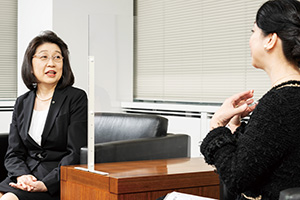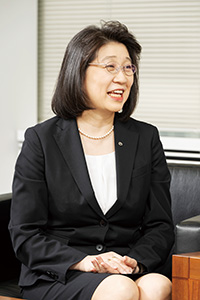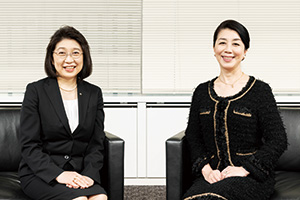 |
|
|
|
|
|
View from the Top Vol. 21, No. 4, pp. 1–5, Apr. 2023. https://doi.org/10.53829/ntr202304tp1
Create as Many Serendipities as Possible. Philosophy of the “Fountain of Knowledge” Is Shared among All Researchers and LaboratoriesAbstractNTT laboratories are engaged in research and development (R&D) of new technologies to solve social issues in collaboration with NTT Group companies and other partners in various fields. We interviewed Atsuko Oka, executive vice president and head of R&D Planning, NTT Corporation, about her approach to R&D and attitude as a top executive striving to create a “smart world” in which people can enjoy the benefits of technology effortlessly. Keywords: R&D, fountain of knowledge, contribution to society Inheriting 75 years of history—This is our second interview since 2019. How has your job changed since you became head of Research and Development (R&D) Planning from head of Technology Planning in 2022? In June 2022, my position changed from head of Technology Planning to head of R&D Planning, the task of which is leading NTT laboratories. I started my career at NTT as a researcher, but I’ve been working outside R&D department and laboratories for a long time, so I feel like I’ve come full circle. I’m often asked about the difference between the Technology Planning Department and R&D Planning Department, so I’ll begin with a brief explanation of each department. The Technology Planning Department formulates policies and strategies concerning NTT’s overall network and information technology infrastructures and promotes digital transformation (DX) by using current technologies; in contrast, the R&D Planning Department builds the foundations for current and future businesses and solving social issues by researching and practicalizing the next technologies. In the Technology Planning Department, I was engaged in the formulation and promotion of policies for the entire NTT Group’s business, including study and promotion of measures concerning construction, maintenance, and disaster countermeasures of telecommunications infrastructure, which is the basis of NTT’s main business, smart-energy business, procurement, and next-generation networks. I also oversaw the promotion of DX using information and communication technology (ICT). While pursuing these missions, I realized the importance of addressing social issues. In my current position, I feel a strong sense of responsibility to help address those issues with the results produced by NTT laboratories. However, there is no infallible formula in research: some technologies will be put to practical use in two to three years, others will be implemented in the very distant future, and in some cases, they will be implemented only after the development of other technologies related to the research in question. That is why I believe it is important to not only conduct innovative research but also continue—in parallel with our daily research activities—research and improve the technologies that we have inherited from the past to produce concrete results while adapting to the times. —NTT has a long history of R&D. Its R&D organization has been reorganized according to the times, hasn’t it? The Electrical Communication Laboratory of the Ministry of Communications was established in 1948 and became the Nippon Telegraph and Telephone Public Corporation’s Electrical Communication Laboratory in 1952. While flexibly changing its R&D organization, NTT has been conducting R&D in accordance with the philosophy of the first director of the Electrical Communication Laboratory, Goro Yoshida, who said, “Do research by drawing from the fountain of knowledge and provide specific benefits to society through its practical use.” It is said that no other telecommunications company in the world has an R&D organization of the scale of ours, and I believe this is one of NTT’s unique characteristics and perhaps one of our greatest strengths. The current NTT R&D organization consists of the following four laboratory groups in which about 2300 researchers are engaged in R&D in a wide range of fields from basic research to applied research: (i) the NTT Service Innovation Laboratory Group, which conducts R&D on innovative communication services that can be implemented on networks and technologies for predicting the future society and feeding them back to the real world; (ii) the NTT Information Network Laboratory Group, which conducts R&D on next-generation information-network-infrastructure technology that will support new services and environmental energy technology; (iii) the NTT Science and Core Technology Laboratory Group, which conducts advanced basic research to create new principles and new components, including world-class optical-related technologies; and (iv) the NTT IOWN Integrated Innovation Center, which conducts R&D on the All-Photonics Network (APN)—which embodies the Innovative Optical and Wireless Network (IOWN) concept—and cross-cutting technologies such as the convergence of “mobile and fixed” and “network and computing.”
Commercialization of IOWN1.0 finally begins—With such a rock-solid R&D organization, what research themes you are currently focusing on? In addition to pursuing IOWN-related projects, we are focusing on collaborating with our partners to contribute to society by fusing our research with their technologies. To give you a recent example, I’ll tell you about R&D for sustainable development concerning food-related issues and carbon neutrality that we are conducting with Kyoto University’s venture company, Regional Fish Institute, Ltd. (RFI). The oceans are said to absorb 34% of the carbon dioxide (CO2) emitted into the atmosphere. With that fact in mind, we are conducting a demonstration experiment of a CO2-conversion technology for reducing the amount of CO2 dissolved in the oceans by applying genome editing technology to the food chain between algae and fish/shellfish. Through such experiments, we have established a method for selecting genes related to traits possessed by algae and have succeeded in identifying genes that are expected to increase the amount of CO2 absorption. Genetically enhancing algae to promote those genes will allow the algae to absorb more CO2 dissolved in seawater, and the side effect of that CO2 absorption is more CO2 being absorbed by the bodies, bones, and shells of the fish and shellfish that feed on the algae. We will conduct genome editing on the identified genes and evaluate the CO2 absorption capacity of the genome-edited algae and identify genes involved in other useful traits. Genes involved in absorption of CO2 may be applicable to plants and other photosynthetic organisms; therefore, we are also creating a dataset on the relationship between genes and trait changes in various organisms and constructing a model for predicting trait changes on the basis of patterns and rules discovered using machine learning. We plan to use the results of this R&D in the Green Food Business project, which is being planned with RFI and other partners, to contribute to reducing the environmental impact of humankind and solving food shortages. —I see that social contribution is a prerequisite for NTT’s R&D. The implementation of IOWN is finally taking off, isn’t it? It has been four years since NTT announced the concept of IOWN. NTT has been conducting R&D on optical fiber since the 1960s, and when I joined NTT in the late 1980s, researchers at that time had already realized that optical technology would bring about technological innovation in the future. However, the optical technology to implement such innovation had not yet developed. Nevertheless, in 2019, it was reported in Nature Photonics that NTT Basic Research Laboratories had developed an electro-optic modulator and optical transistor that operate with the world’s lowest energy consumption, and that achievement led to the concept of IOWN based on optical technology. The research activities concerning IOWN have accelerated since then. The initial target was to implement IOWN by 2030; however, the recent rise in expectations for technological innovations that contribute to addressing social issues, such as reducing the environmental impact and electric power consumption, has increased the pace of R&D and brought forward the launch date. In response to this situation, we need to start developing infrastructure ahead of commercialization, so we have started construction of the IOWN testbed and other network environments. In March 2023, NTT EAST and NTT WEST launched “IOWN1.0” as the first APN service. The prime value of the new APN service is ultra-low latency. We intend to commercialize a low-power consumption server equipped with the photonics-electronics converged devices that are currently under development in 2026. By combining this server with the APN, we will achieve low-power-consumption, large-capacity, and low-latency communications. At Expo 2025 Osaka, Kansai, Japan, in addition to exhibiting a pavilion, we plan to provide virtual venues, “personal agents” for visitors, and announce the IOWN2.0 service as a showcase for IOWN.
Do not force people to use our technologies—Could you tell us what is important to you as the head of R&D Planning? Now that I’m an executive vice president of NTT, I feel more strongly than ever the responsibility to steadily achieve goals set in our medium-term management strategy and other plans. I cannot do much on my own to solve the problems that arise in the process, so I seek help from those around me as I proceed. Once a month, I meet with the heads of each laboratory group to share policies and strategies to ensure that our direction is consistent. Since the number of collaborations between the laboratories that make use of one another’s originality and unique research themes is increasing, I want to create many collaborative projects. We cannot always know where to apply our research results and developed technologies, and we should not force people to use our technologies. I want to make every effort to turn our research results into business with a goal of solving social issues. Cooperation with a variety of people is key to achieving this goal. To make sure that our partners, many of whom are not ICT experts, choose us for their collaborations, we make every effort to communicate with them, plan collaborations, and explain technologies in a way that is easy to understand. For example, at the NTT R&D Forum in 2022, which was held online and in-person for the first time in three years after the COVID-19 pandemic, we improved the presentations and exhibits in various ways, such as enlarging the pop-up panels to make them easier to understand and deepen the understanding of the audience. Let me introduce an example of such efforts with the bio-digital twin, which is a use case in the medical and healthcare field of Digital Twin Computing, a component of IOWN. With the bio-digital twin, a model of the human heart is created in digital space by inputting heart-rate and blood-test data. When explaining this technology, we not only provide information on whether the patient’s current cardiopulmonary function is average or slightly declining but also information that stimulates the curiosity of the audience, such as a simulation that predicts the cardiopulmonary function at future intervals and instantly shows how it will deteriorate if it is not improved. In this manner, we try hard to deepen the audience’s understanding by providing explanations that take into account the viewpoints of the general public and physicians. —What is your message to researchers and partners and your thoughts about the future? As I mentioned above, the philosophy and purpose of NTT’s R&D are summed up in the words of our first director, Goro Yoshida. Under this philosophy, I believe that we are required to return the knowledge we accumulate to society. Since we are the research institute of a company, NTT, we also naturally need to contribute to NTT’s business. On top of meeting that necessity, we will continue to maintain the mindset and DNA of contributing to society through our business. Each laboratory and each researcher has different phases of development and missions, and the timings at which they produce results also differ. Even so, I believe that the philosophy of the “fountain of knowledge” is universal. In this rapidly changing world, there is a limit to what one person can do, so I encourage researchers to communicate with a variety of people to get inspiration and tips to brush up their skills. I also hope many people want to co-create with us, but I have heard comments like “NTT is a large company, so it is difficult to approach them.” If that is the case, NTT researchers will provide a thorough and easy-to-understand explanation of their research, so nobody will hesitate to contact us. Finally, with 116 members (as of February 6, 2023) from all over the world, the IOWN Global Forum aims at global technological innovation. I expect to develop more products and services with the IOWN name in cooperation with those members. We hope to create as many serendipities as possible through our collaboration and produce and discover more value than we could have ever imagined.
Interviewee profileCareer highlightsAtsuko Oka joined NTT as a researcher at Software Research Laboratories in 1988. After serving as the director of the IP Services Department of the Net Business Division of NTT Communications Corporation from 2006 to 2010, she became the president and CEO of NTT NaviSpace Corporation in 2010, a board member and general manager of the Solution Business Division of NTT Resonant Incorporated in 2017, and senior vice president and head of Technology Planning, NTT Corporation in 2019. She assumed her current position in June 2022. |




